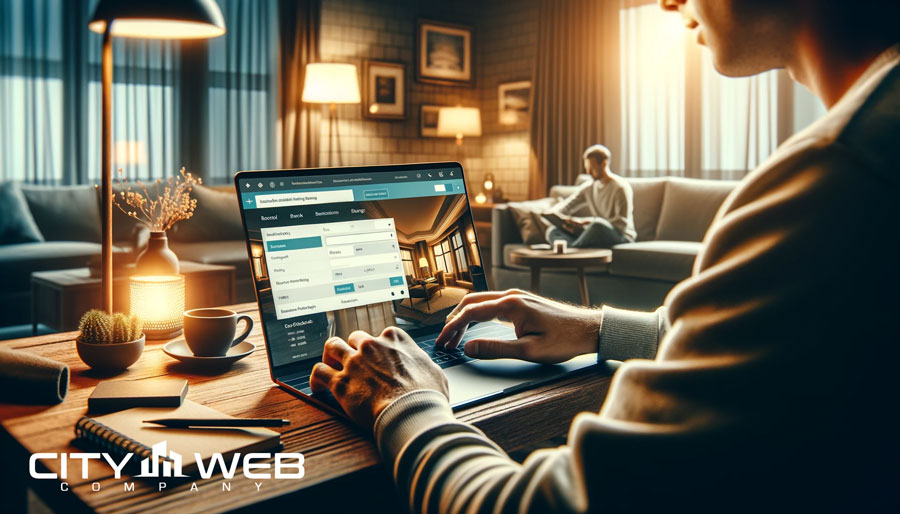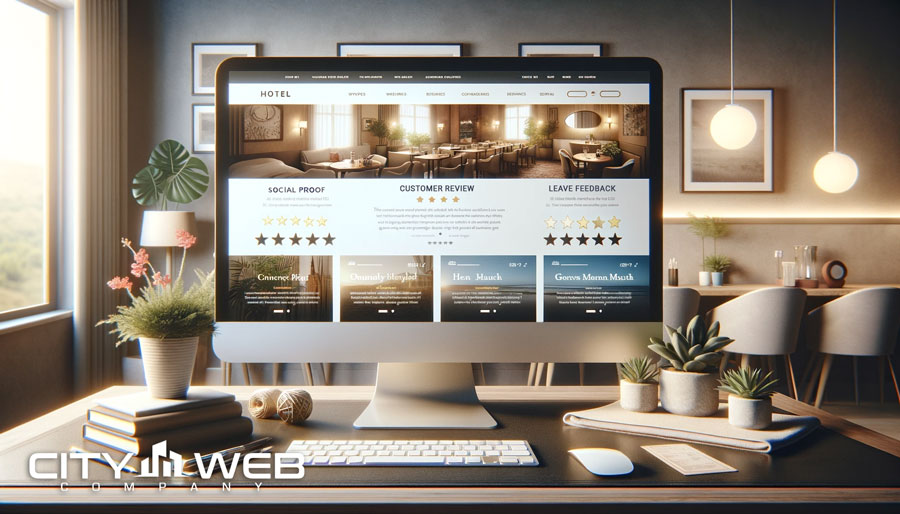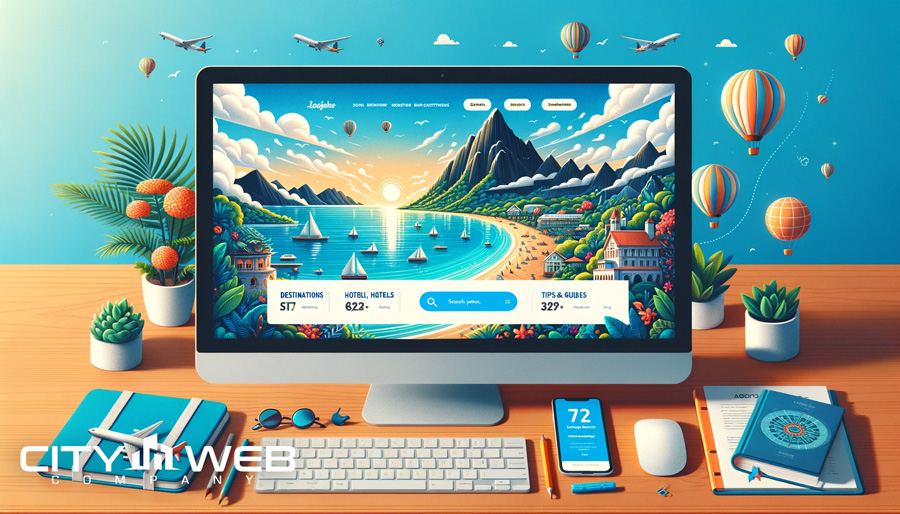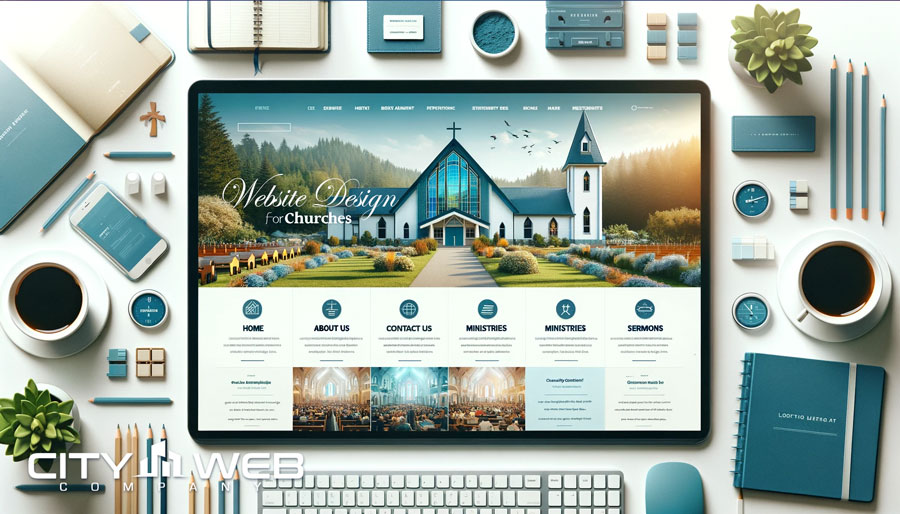Best Web Design Grand Junction: Expert Tips Navigating the web design landscape in Grand Junction…

Best Website Design for Hotels: Improve Your Hotel’s Online Presence
Table of Contents
Best Website Design for Hotels: Improve Your Hotel’s Online Presence
Picture this: You’ve just spent months renovating your hotel, crafting an exquisite haven for guests to escape to. But does your online presence mirror the sophistication and comfort found within your walls?
Your hotel’s website design can make or break this impression.
The landscape of digital hospitality demands more than just functionality; it requires a blend of aesthetics, user experience, and strategic storytelling.
Elevating First Impressions
Your hotel’s digital facade serves as the virtual concierge, greeting potential guests. It’s a critical conduit that conveys your hotel’s ethos and aesthetic appeal before a foot is set on premises.
A judiciously designed homepage, enriched with high-definition imagery and intuitive navigation, leaves an indelible mark, quietly assuring visitors of the refined experience awaiting them. Every pixel and placeholder must reflect the hotel’s character, beckoning users to explore further.
To materialize that impactful “welcome,” harmonize state-of-the-art design with the hotel’s unique narrative. This synthesis creates a virtual lobby as captivating as the physical one, fostering an immediate, resonant connection with viewers.
Our partner company WP Commander specializes in maintaining your WordPress website for one low monthly price.
Contact City Web Company or visit: WP Commander to learn more how we'll give your website the white-glove treatment!

Key Points:
- Importance of a well-designed website for hotels
- Essential features for a hotel website
- Tips for optimizing your hotel’s online presence
- Well-designed website enhances user experience
- Mobile responsiveness is crucial
- Clear and intuitive navigation
- High-quality visuals and engaging content
- Integration with online booking platforms
- Optimize website for search engines
- Use relevant keywords in page titles and headings
- Create unique and informative meta descriptions
- Improve website loading speed
- Implement schema markup for better search visibility
- Leverage social media and online reviews
- Engage with customers through social media platforms
- Encourage guests to leave positive reviews
- Respond promptly to customer feedback
- Showcase positive reviews on your website
- Monitor and analyze website performance
- Use analytics tools to track website traffic and user behavior
- Identify areas for improvement and make necessary adjustments
- Regularly update and maintain your website to ensure optimal performance
Visually Stunning Homepage
A homepage’s allure is pivotal; it’s the digital embodiment that mirrors your hotel’s physical elegance and charm.
Striking visuals elevate user experience, enticing viewers into a narrative journey echoed by the hotel’s unique ambiance.
High-resolution images teamed with a sophisticated color palette set the mood, while fluid design elements guide the user gracefully through your digital space.
Subtle animations and a thoughtful layout not only reflect luxury and exclusivity but also ensure the homepage is the cornerstone of your hotel’s online narrative.
Intuitive Navigation
An intuitive navigation system acts as the compass for visitors, guiding them effortlessly through the website’s offerings.
- Home: A single-click return to the starting point.
- Rooms and Suites: Detailed visuals and information about accommodations.
- Amenities: Overview of facilities like spas, pools, and dining options.
- Booking: Clear, accessible reservation interface.
- Special Offers: Promotions and packages highlighted.
- Gallery: Captivating images of the property and experiences.
- Location: Interactive map and transport details.
- Contact Us: Easy-to-find contact information and forms.
It should feel as though each click anticipates the user’s needs, providing information logically and accessibly.
A well-crafted navigation enhances the user experience, ensuring that potential guests find what they seek with minimal effort and maximal satisfaction.
Streamlining the Booking Experience
To optimize your hotel’s booking process, it is crucial to implement a design that minimizes obstacles and maximizes efficiency. This entails a reservation system that is seamless, swift, and secure. Guests should encounter an interface where room selection, date availability, and rate transparency converge intuitively, allowing for a smooth transition from browsing to reservation confirmation. The fewer the steps and the clearer the instructions, the higher the likelihood that a visitor will complete their booking – a paramount metric in hospitality web design. Therefore, ensuring that this process is flawless is not merely an enhancement of user experience but a vital aspect of conversion rate optimization.
Simplified Reservation Process
The ideal reservation interface is characterized by clarity, speed, and ease of use, guiding guests seamlessly through the booking journey. The objective should be to distill the process down to its essence, presenting the available rooms, rates, and dates in a straightforward manner that aligns with guest expectations. A multi-step reservation process should be reduced to the fewest possible steps without compromising precision or guest reassurance.
Navigation through the booking system must be intuitive and require minimal input from the user. Intuitive design leads to a more confident and committed booking experience.
Entering personal details should be effortless, with auto-fill options (where appropriate) and clear form fields to reduce friction. This level of simplification facilitates a smoother transaction for the guest.
Every additional click can lead to potential abandonment of the booking process. Therefore, the call to action needs to be prominent, persuasive, and readily accessible to keep the user engaged and moving through to confirmation.
A robust reservation system should dynamically update in real-time to reflect changes in availability or pricing, thus providing guests with the assurance that they are securing the best deal possible at the time of booking. This transparency in availability and pricing is imperative for maintaining trust between the hotel and its guests.
Finally, the process should be adaptable to mobile interfaces, ensuring functionality and ease across all devices. Responsive design elements are key to accommodating the rising number of travelers who book exclusively via mobile platforms.

What are some effective strategies for integrating online booking systems into a hotel website’s design?
When it comes to integrating online booking systems into a hotel website’s design, there are several effective strategies that can be implemented. These strategies aim to optimize the user experience while ensuring a seamless booking process for potential guests. Here are a few recommended approaches:
- Clear and Prominent Call-to-Action: Place a prominent “Book Now” or “Check Availability” button at strategic locations throughout the website, such as the homepage, room descriptions, and special offers. This makes it easy for users to find and initiate the booking process.
- Streamlined Booking Process: Simplify the booking process by minimizing the number of steps required to make a reservation. Implement an intuitive interface that guides users through each step, reducing any confusion or frustration.
- Real-time Availability and Rates: Integrate the online booking system with the hotel’s reservation management system to provide accurate real-time availability and rates. This ensures that users are always presented with up-to-date information, avoiding any potential discrepancies.
- Mobile-Friendly Design: Optimize the hotel website for mobile devices to cater to the increasing number of users who prefer booking on their smartphones or tablets. Implement responsive design techniques that adapt the site’s layout and functionality to different screen sizes and resolutions.
- Guest Feedback and Reviews: Display guest reviews and ratings prominently on the website to build trust and credibility. Ensure that the online booking system allows guests to leave reviews after their stay, as positive feedback can influence potential guests to book.
- Seamless Integration: Work closely with the online booking system provider to ensure seamless integration with the hotel website. This includes matching the branding and design elements to create a cohesive user experience.
- Secure Payment Processing: Implement a secure payment gateway to protect guest data and build trust. Utilize industry-standard security protocols and display trust seals to give users confidence in making their bookings.
By incorporating these effective strategies, hotels can seamlessly integrate online booking systems into their website design, providing a user-friendly and efficient booking experience for potential guests.
Mobile-Friendly Design
In today’s digital landscape, a mobile-friendly design is not simply a competitive edge; it’s a necessary standard for hotel websites. The design should ensure usability, accessibility, and performance on all mobile devices, matching or exceeding the desktop experience in quality and efficiency.
Responsive layouts are imperative, fluidly adapting to different screen sizes and orientations. Navigation should be intuitive, with touch-friendly elements.
As mobile users often seek information rapidly, the website must load efficiently, with optimized images and lean code underpinning a streamlined user experience. Fast load times are crucial in reducing bounce rates and engendering guest confidence in the brand.
A mobile-friendly website amplifies the hotel’s online visibility. Search engines like Google prioritize mobile-optimized sites in their rankings. Thus, a comprehensive mobile strategy is vital not only for user satisfaction but also for search engine optimization, driving organic traffic, and ultimately, conversions. This is in line with Google’s “mobile-first” indexing, which underscores the importance of a robust mobile web presence.
Enhancing Visual Storytelling
Effective visual storytelling engages the viewer, creating an immersive experience that not only showcases the amenities but also conveys the atmosphere of your hotel. It is through such dynamic visual narratives that potential guests form an emotional connection, envisioning themselves within the spaces you present. Hence, the strategic selection and placement of visuals become a cornerstone of persuasive website design.
To achieve this, consider employing high-resolution images that are evocatively composed; imagine each photograph as a frame in a larger story of relaxation, adventure, or luxury that your hotel promises. Additionally, incorporating interactive elements like virtual tours and video content can add layers to the narrative. These multimedia elements should not only align aesthetically but also load swiftly to maintain engagement and foster a seamless online journey reflective of the guest experience your hotel aims to deliver.
Professional Photography Tips
Capture the quintessence of your hotel.
When it comes to hotel photography, ambiance is paramount. You aim to encapsulate the essence of your accommodations through visuals that speak volumes to the observer. It’s not solely about presenting the physical space, but rather burgeoning an emotional allure that resonates with viewers. Exceptionally, lighting plays a pivotal role in the cultivation of these emotions, turning a mere image into an evocative experience.
Avoid clichéd compositions and angles.
Diversifying your visual perspective is central – break free from conventional shots. Engage potential guests with unique viewpoints and compositions that stand out. This approach encourages a fresh visual dialogue with your audience and distinguishes your property’s imagery from the commonplace, drawing in viewers with authentic, eye-catching depictions of your spaces.
Delve into the details with precision.
Use high-quality equipment to capture the finest details – from the texture of the linen to the elegance of the decor. These minute features are the threads that weave the tapestry of opulence and comfort your hotel epitomizes. They narrate the meticulous attention you devote to guest experience and become the subtle yet striking elements that elevate your online presence.
Evoke emotion through storytelling in every frame.
Your imagery should tell a compelling tale. To forecast into the future, consider integrating themes and designs that champion an evolving visual narrative. Each photograph should be more than just an image; it should be a canvas where every element synergizes to portray the uniqueness and essence of the experience that awaits in your hotel.
Engaging Virtual Tours
Innovate with immersive experiences that captivate potential guests. Integrating high-definition 360-degree virtual tours can transform a static webpage into a portal into your hotel, allowing visitors to walk through your rooms, lounges, and dining areas virtually, thus fostering a stronger connection and kindling the desire to experience it physically.
Virtual reality elevates the ordinary to extraordinary. Simple photographs of your spaces serve a purpose, but virtual reality experiences invite users to envelop themselves in your hotel’s ambiance from the comfort of their homes.
With advancements in technology, engaging virtual tours become increasingly intuitive, leveraging user-friendly interfaces to allow prospective patrons a seamless glide through your establishment. Such tours should be comprehensive yet easy to navigate, offering a bird’s-eye view or a ground-level stroll with equal ease.
To create a truly encompassing virtual presence, high-resolution imagery must be harmoniously stitched together, creating an uninterrupted narrative of your property’s luxury and hospitality. Integrated with succinct, evocative descriptions, these virtual tours can serve as digital concierges, guiding visitors through your amenities and services, and laying the foundation for an inevitable in-person visit.
Maximizing User Engagement
Interactive elements foster dynamic exploration. By integrating responsive design elements like drop-down menus and sliders, users can tailor their virtual tour experience, facilitating a sense of control and personalization.
Incorporating real-time data delivers tangibility to virtual exploration. Live weather updates, event calendars, and special offers become compelling hooks that entice users to convert their digital curiosity into tangible bookings, enhancing the relevance of your online presence.
Leverage user feedback to refine experiences. Implementing guest reviews and ratings not only boosts credibility but also informs potential guests, promoting an informed decision-making process.
Persuasive Call-to-Actions
Compelling calls-to-action (CTAs) are the linchpins of successful conversions, beckoning prospective guests to embark on the booking journey. Expertly crafted, they channel the user’s interest into decisive action, making the path from curiosity to reservation clear and irresistible.
Craft CTAs with imperative vigor and clarity in order to help achieve the best website design for hotels.
Ensure that each CTA is strategically placed, leveraging the high-impact points of user interaction. Their prominence (visual hierarchy and psychological positioning) should naturally guide the users toward conversion.
Introduce scarcity and urgency with timed offers and limited availability alerts, driving faster decision-making and increasing conversion rates.
Smart CTAs adapt to the user’s journey—personalizing messages based on the browsing history and preferences, thus resonating with their specific travel aspirations. This targeted approach significantly elevates engagement and conversion likelihood.
CTAs can include features such as a newsletter sign-up, membership sign-up, coupon codes, and “book now” buttons. For an easy-to-use newsletter and email marketing platform, we recommend a provider such as Mailchimp.
Reinforce the value proposition with each CTA. Highlight exclusive benefits, such as free upgrades or late check-out, to incentivize immediate bookings and set your hotel apart from competitors.
Remember, the goal is to align the user’s desire with your hotel’s offerings, weaving a narrative that culminates in a seamless booking experience. The right combination of urgency, value, and personalization can transform a prospective guest into a confirmed reservation.

Social Proof Integration
If you want the best website design for hotels, incorporating Social Proof is an absolute must.
In the realm of online hotel marketing, social proof plays a pivotal role. This influential element acts as a trust signal for prospective guests, translating into increased conversions and bookings. Whether in the form of customer testimonials, ratings, or embedded social media feeds, social proof serves as a compelling endorsement of your hotel’s quality and service.
Empower your guests to become brand advocates.
Employing user-generated content is imperative – from curated reviews to vibrant guest images. By showcasing real-life experiences on your website, you validate your offer’s credibility and charm potential customers. Indeed, it is the raw testimonials from former guests that frequently seal the conversion deal. One of the best methods for displaying user-generated content is through online reviews, allowing guests to share their experiences with potential new guests. The best most affordable and easy-to-use Customer Review Software is TurnKey Reputation, which will automate the process of capturing and marketing positive reviews, while helping to keep negative reviews and feedback in-house.
Rich visual content nurtures the hotel narrative.
The strategic placement of this content, accompanied by tasteful design elements, cultivates an environment of authenticity and trust. Keeping this updated is crucial; hence, integrating dynamic feeds that pull the latest reviews or social posts ensures a fresh and appealing user experience. This dynamic approach underscores a commitment to customer satisfaction and reflects the current guest sentiment.
Final Thoughts on the Best Website Design for Hotels
Having the best website design for hotels is crucial in improving your hotel’s online presence. A well-designed website enhances user experience, optimizes search engine visibility, and leverages social media and online reviews. By monitoring and analyzing website performance, you can continuously improve and maintain your website to ensure optimal results. If you’re ready to take your hotel’s online presence to the next level, contact City Web Company today to start your new hotel website project. Our team of experts will showcase your expertise and attention to detail, helping you attract more guests and boost your hotel’s success.
Frequently Asked Questions
Improve Your Hotel’s Online Presence with the Best Website Design
Q: Why is a well-designed website important for hotels?
A: A well-designed website is important for hotels as it enhances user experience, showcases your hotel’s offerings, and helps attract potential guests.
Q: What are the essential features for a hotel website?
A: Essential features for a hotel website include mobile responsiveness, clear navigation, high-quality visuals, engaging content, and integration with online booking platforms.
Q: How can I optimize my hotel’s website for search engines?
A: To optimize your hotel’s website for search engines, use relevant keywords in page titles and headings, create unique meta descriptions, improve loading speed, and implement schema markup for better search visibility.
Q: How can I leverage social media and online reviews for my hotel’s online presence?
A: You can leverage social media and online reviews by engaging with customers through social media platforms, encouraging guests to leave positive reviews, responding promptly to customer feedback, and showcasing positive reviews on your website.
Q: How can I monitor and analyze my hotel website’s performance?
A: You can monitor and analyze your hotel website’s performance by using analytics tools to track website traffic and user behavior, identifying areas for improvement, and regularly updating and maintaining your website for optimal performance.
Subscribe
Login
0 Comments




